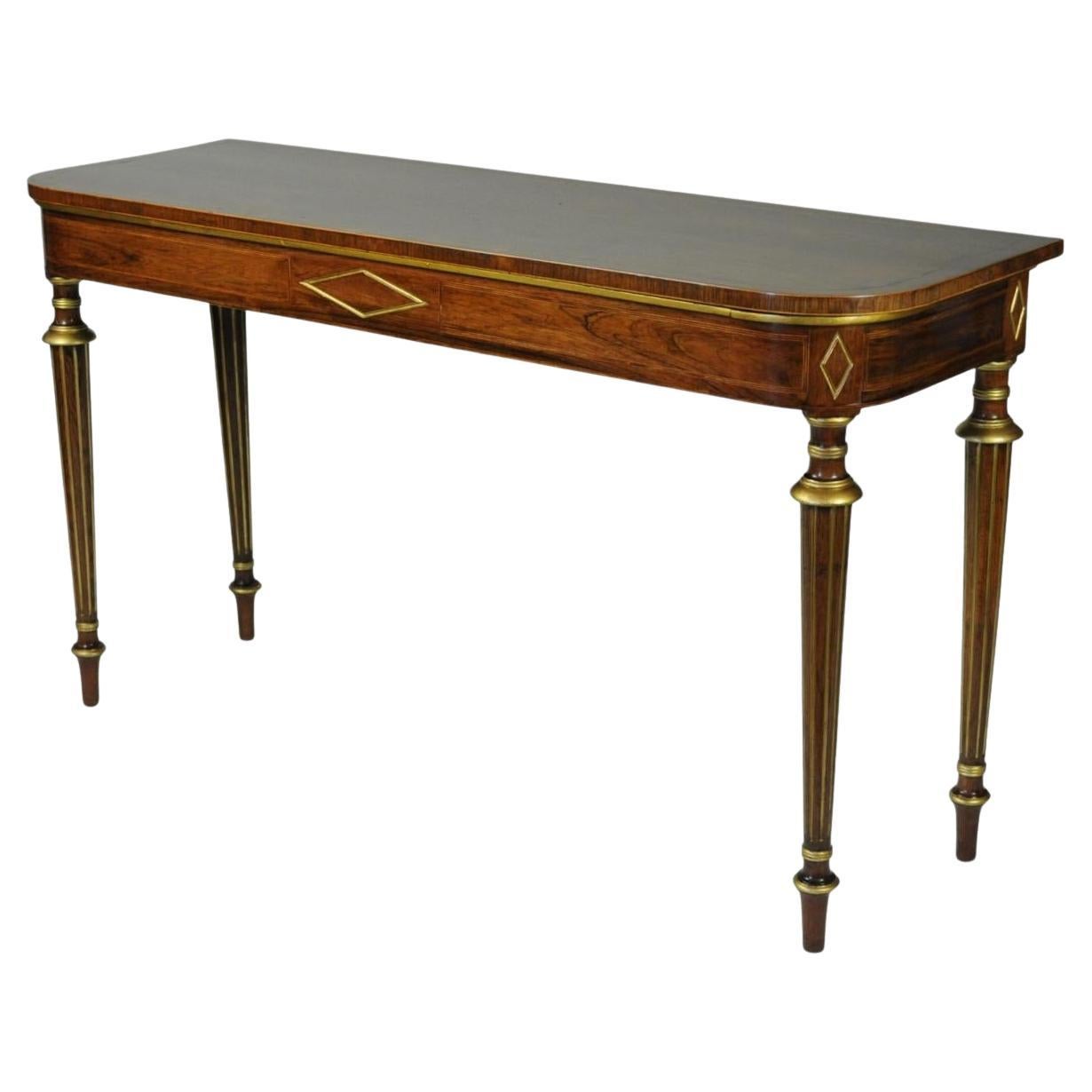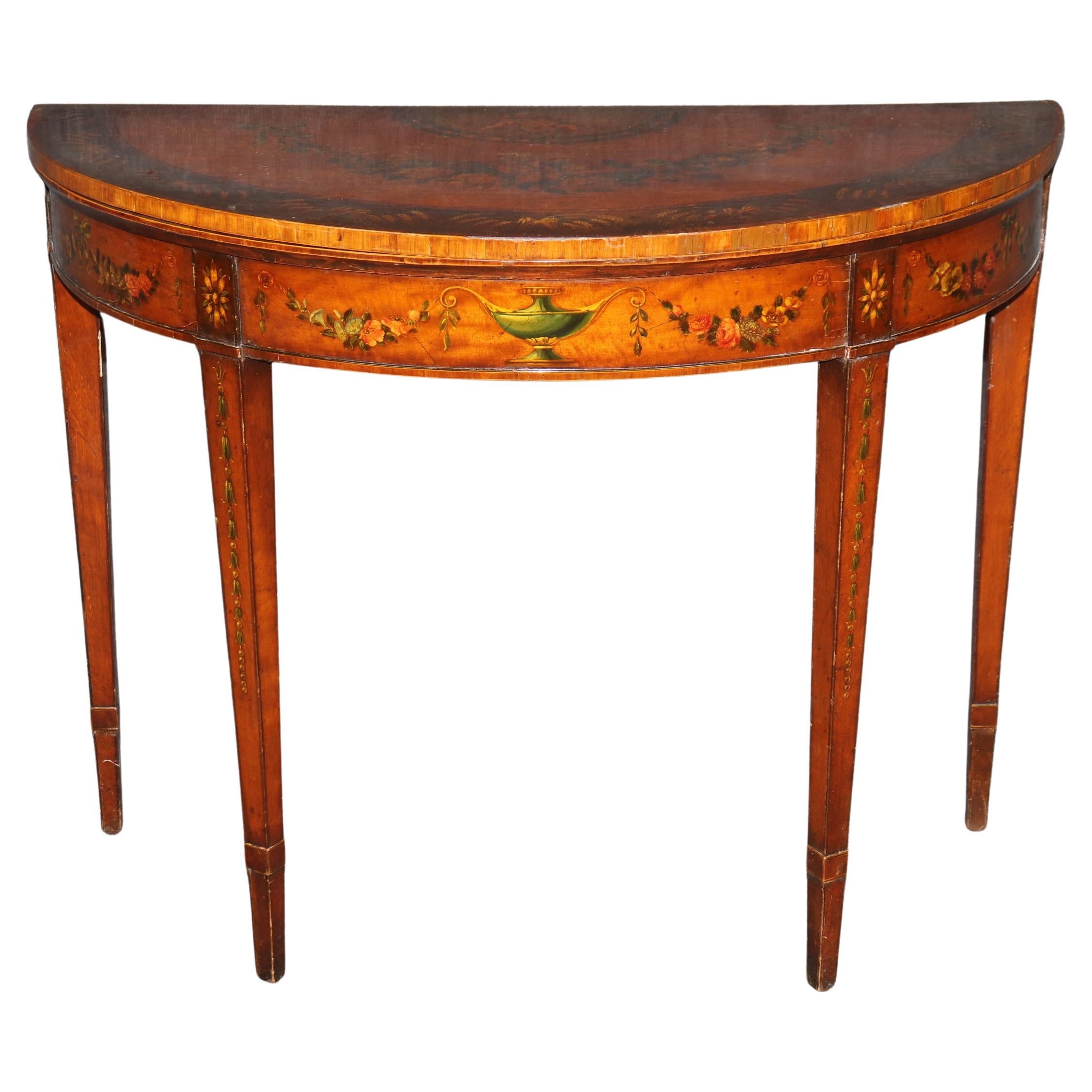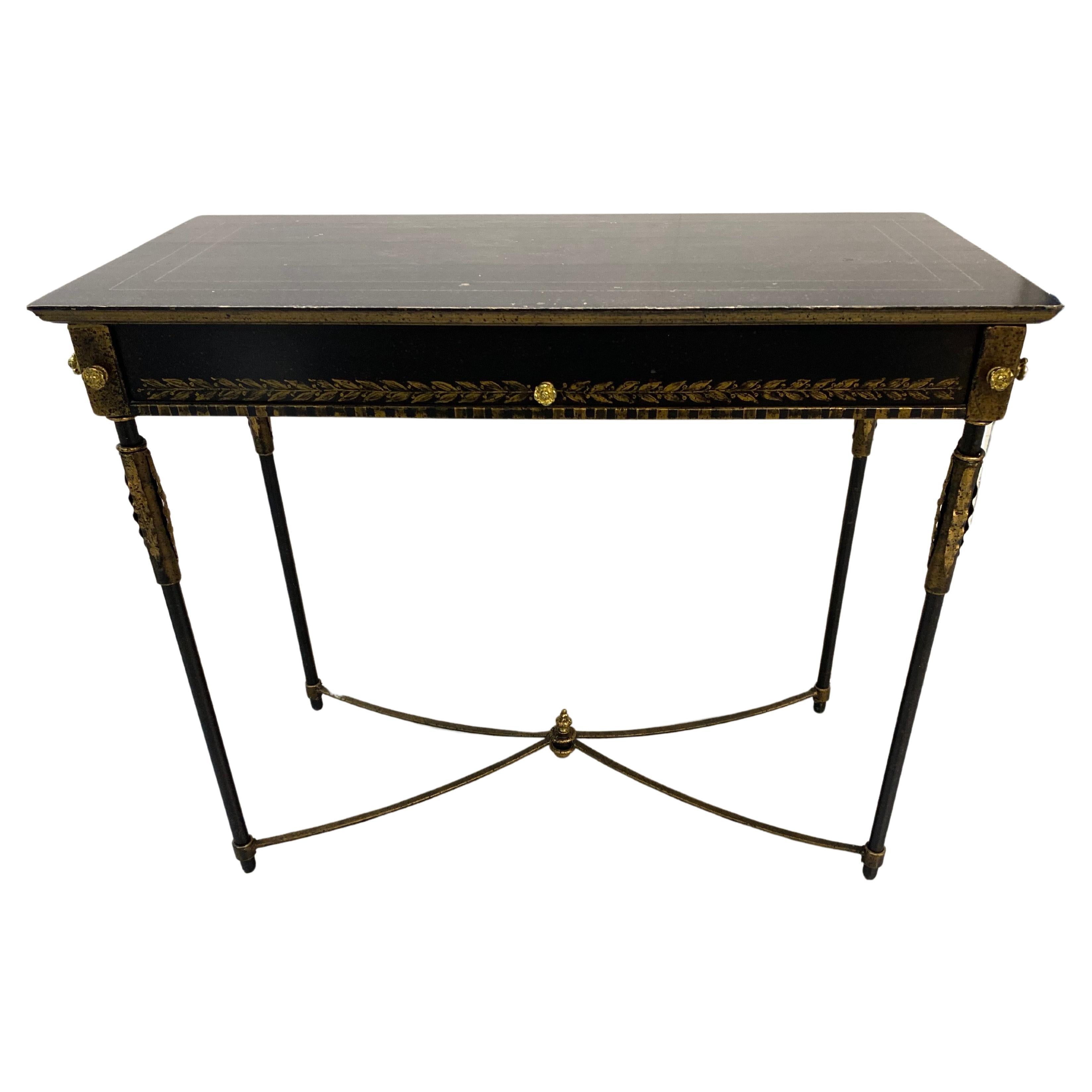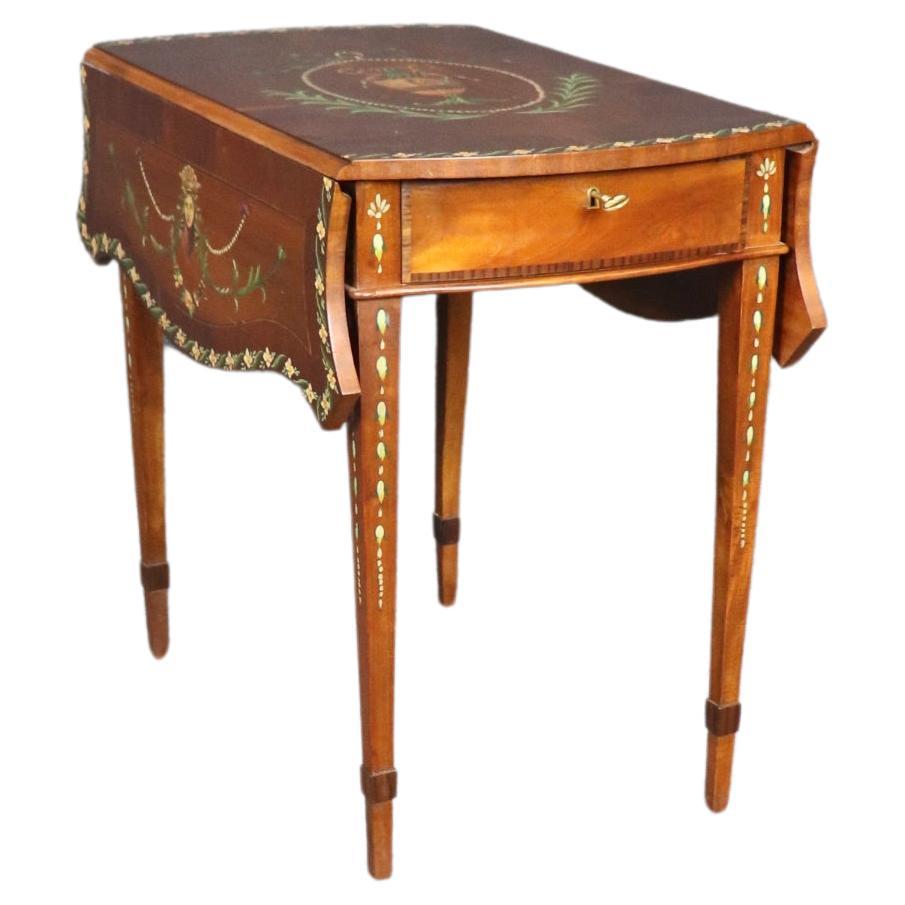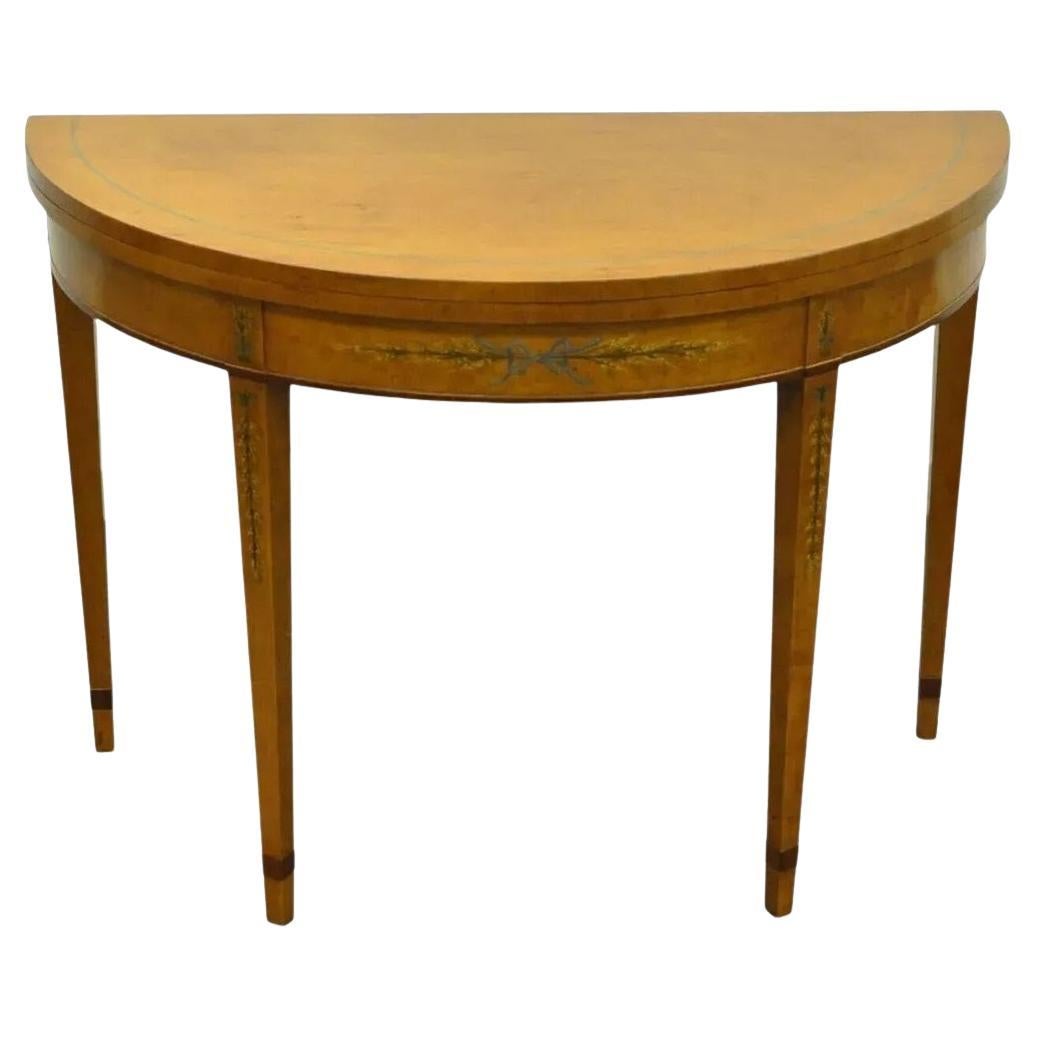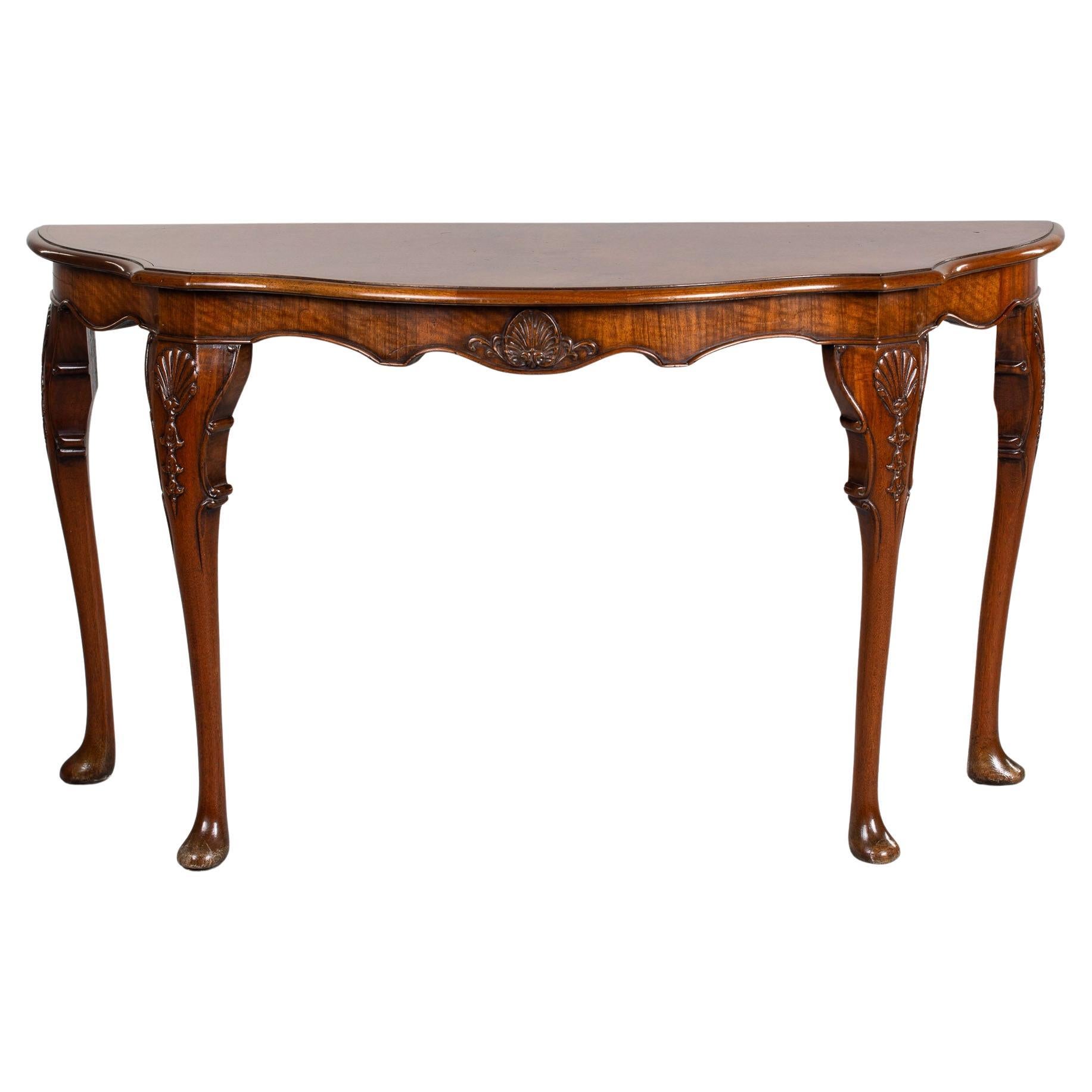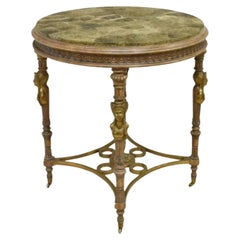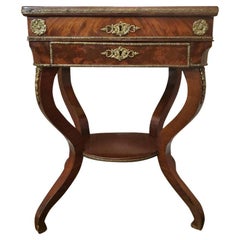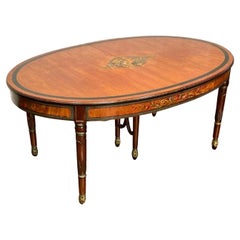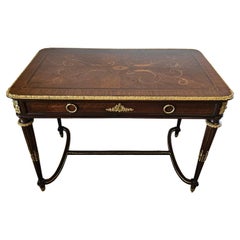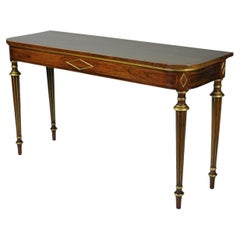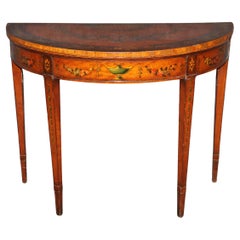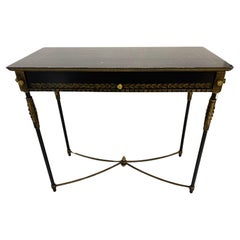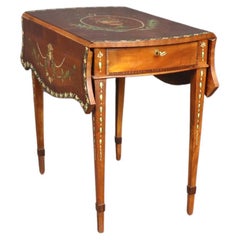Items Similar to Lane Venture Bespoke Adam Style Raymond Waites Demilune Table
Want more images or videos?
Request additional images or videos from the seller
1 of 8
Lane Venture Bespoke Adam Style Raymond Waites Demilune Table
$3,380
£2,575
€2,938.68
CA$4,749.70
A$5,176.34
CHF 2,741.09
MX$62,173.26
NOK 34,702.85
SEK 31,905.86
DKK 21,948.70
About the Item
An exceptional bespoke Adam style indoor/outdoor console table designed by Raymond Waites (couture customized upholstery and interiors) for Lane Venture (high-end casual indoor/outdoor luxury furnishings).
The beautiful American made custom antique reproduction was handcrafted by highly skilled artisans, using only the finest of high quality materials. Originating from the Excursions collection, the demilune form - half-moon shape table features black distressed painted finish adorned with polychromed ribbon swags and floral motifs. Richly decorated with silver-gilt and gold-gilt, embodying sophisticated elegance. Three drawers around the apron utilize space well, providing generous storage. The detailed hand painted ornamentation continues on the four ebonized, turned and tapered legs.
Circa late 20th / early 21st century; North Carolina, United States.
Dimensions (approx):
30.25"H, 37.75"W, 20.25"D
Excellent condition. Original. Delivered cleaned, waxed, polished and ready for immediate use.
- Dimensions:Height: 30.25 in (76.84 cm)Width: 37.75 in (95.89 cm)Depth: 20.25 in (51.44 cm)
- Style:Adam Style (In the Style Of)
- Materials and Techniques:
- Place of Origin:
- Period:
- Date of Manufacture:Late 20th-Early 21st Century
- Condition:Wear consistent with age and use. Excellent condition. Original. Delivered cleaned, waxed, polished and ready for immediate use.
- Seller Location:Forney, TX
- Reference Number:1stDibs: LU5977226087922
About the Seller
4.8
Platinum Seller
Premium sellers with a 4.7+ rating and 24-hour response times
Established in 2013
1stDibs seller since 2021
315 sales on 1stDibs
Typical response time: 1 hour
- ShippingRetrieving quote...Shipping from: Forney, TX
- Return Policy
More From This Seller
View AllVintage French Guéridon Table after Adam Weisweiler
By Adam Weisweiler
Located in Forney, TX
A very fine quality French gueridon, exceptionally executed in the manner of the original design by Adam Weisweiler (1744-1820).
Finished in sophis...
Category
Late 20th Century Louis XVI Gueridon
Materials
Marble, Bronze, Ormolu
19th C. French Charles X Restoration Period Sewing Stand Work Table
Located in Forney, TX
A scarce period Charles X (1818-1834) French Restoration mahogany travailleuse sewing (thread stand - side table - jewelry dressing table) with light, warm, beautifully aged patina.
Born in France in the early 19th century, almost certainly Parisian work, exquisitely hand-crafted, this exceptionally executed example features ornate gilt bronze ormolu mounts, escutcheons, and elaborate gilt metal trim. Having a highly figured light mahogany hinged lid top, lifting open to reveal a striking finished interior with divided compartments and original inset mirror plate. The conforming rectangular case fitted with a faux drawer front over a dovetailed drawer with sectioned interior. Elegantly rising on oval-shaped medial shelf stretcher-joined curvacious legs.
Dimensions (approx):
27" High, 20" Wide, 13.5" Deep
Stunning light almost blonde antique mahogany coloring and mellow warm tone, superb wood grain detail, and charming, beautifully aged patina over the whole. Great shape overall. Retaining original antique character marks, wear consistent with age and indicative of minimal use, nothing that detracts from the aesthetics or functionality, but only adds to the overall authenticity, refined elegant warmth, luxurious sophistication, and cozy unpretentious rustic elegance.
Delivered cleaned, hand waxed, polished French patina finish, ready for immediate use and generational enjoyment!
What is Charles X style:
The comte d’Artois – or Charles X - was the son of the dauphin Louis-Ferdinand de Franc and Marie-Josèphe de Saxe. He succeeded his two brothers Louis XVI and Louis XVIII and became the King of France in 1824. Thirty years after the French Revolution, he wanted to embody the return of monarchy and became the leader of the catholic party . As the previous kings, he was crowned in 1825 but he was soon overthrown by the revolution in July, 1830, called "Trois Glorieuses". He left then for England, Scotland, Prague and Istria where he died in 1836.
Charles X style lasted from 1818 to 1834 and happened during the Bourbon Restoration (French Restoration). This style did not replace totally the style of furniture from the French Empire but it was different from the formalism in the Napoleonic era, during which strictness and simplicity were inspired by Greco-Roman art. Indeed, artistic fields flourished. In terms of furniture, this renewal was suggested by the softening of shapes. Even though the simple aspect from the French Empire was still visible, shapes became curvier with volutes and arabesques. Another distinction is the loss of the massive aspect of furniture and the decrease of dimensions in order to decorate smaller appartments. Handling ability and comfort were key-words in the making of furniture. Apartments had essential elements such as chests of drawers, big rounded tables in the dining room, desks or secretaries, armoires and even dressing tables, comfortable fainting couches in the living room, small tables, pedestal tables, as well as gondola chairs. The wavy aspect of the latters certainly represent Charles X style the best.
One of the most emblematic features of this style is the use of bois clairs – light woods in warm blond tones - and indigenous woods that are varnished in order to highlight the grains. Bird's-eye maple, ash trees, plane trees, yew trees, beech trees, olive trees and cedar trees were most likely to be used. Indeed, at the beginning of the 19th century dark woods were hard to find. In 1806, the Napoleon’s Continental System was established in order to ruin the United Kingdom by preventing the country from any business with the rest of Europe. Therefore craftsmen had to find alternatives from mahogany which was the most commonly used material at this time. After 1815, the import of wood was even more difficult because of peace treaties and the European political situation, which contributed to the popularity of the bois clairs and indigenous woods. The furniture was often decorated with fine inlays made out of dark wood representing foliage, which contrasted with the veneer. Even though these patterns can look like bronze decorations from the Empire era, they were far more simple and did not represent any military or mythological attributes. On the tables, trays were sometimes made out of marble as in the French Empire, but it was often put aside and inlaid veneer, Verre Eglomisé – a type of glass with a mirror finish –, mirror or porcelain from Sèvres or Paris were more likely to be used.
Decorative elements from the Monarchy were highly appreciated again as they suggested luxury. Indeed, marquetry work was particularly fashionable - Boulle marquetry thrived around 1820 as the works of the Levasseur family can show. In the same way, draperies and trimmings referred to the monarchist splendour. Fabrics were often white – the traditional colour of the Bourbons – or light coloured as oppposed to the typical green from the Napoleonic era.
One of the most symbolic figures from this period of time might be Jean-Jacques Werner (1791-1849), a cabinetmaker who worked for prestigious clients such as the Duchesse de Berry who was Charles’s step-daughter. His works can be seen at the Musée des Arts Décoratifs and at the Grand Trianon in the Palace of Versailles. The duchess’s appartments situated at the pavillon de Marsan and at the Palais de Saint Cloud illustrate Charles X style the best with furniture made out of bois clairs and ornamented with dark wood patterns or fine gold decorations.
Chales X style allows a transition between the sobriety of the Empire style and the abundant aspect of Louis-Philippe style. The gothic style started at this time through the "style à la cathédrale", inspired by religious architecture, which thrived from 1827 to 1830. Indeed, at the beginning of the 19th century, Romanticism put the spotlight on the Middle Ages. Cabinetmakers were not inspired by the medieval furniture but rather by architectural elements of churches and cathedrals. For instance the backs of chairs were decorated with arches shaped like rib and serration. In the same way, before Charles X abdicated, pieces of furniture were made out of dark woods – such as mahogany, which was used again in France – and were inlaid with light wood. Romanticism also influenced the layout of furniture in appartments to suggest movement through a mix of various styles, various shapes and various sizes, as opposed to the static aspect of Neoclassicism. The start of industrialisation and mechanisation also influenced this style as early technical developments led to the production of pieces of furniture in series.
Credit:
Marc Maison
Bibliography:
FANIEL Stéphane (Dir.), Le Dix-neuvième Siècle Français, Collection Connaissance des Arts, 1957, Hachette
SASSONE, Adriana Boidi, Furniture from Rococo to Art Deco, 2000, Evergreen
--
Extremely versatile:
As warm and attractive as it is useful, this remarkable antique table having the ideal size and small proportions for a variety of different uses, including as a side table, accent or occasional table, tall sofa...
Category
Antique Early 19th Century French Charles X End Tables
Materials
Bronze, Ormolu
English Edwardian Period Adam Style Cocktail Table
Located in Forney, TX
A one-of-a-kind Edwardian period (1901-1910) English Adam taste paint decorated satinwood extension dining breakfast table, professionally converted to a cocktail table, with reduced...
Category
Early 20th Century English Edwardian Coffee and Cocktail Tables
Materials
Bronze
Maison Forest Signed French Louis XVI Style Writing Table - Late 19th Century
By Maison Forest
Located in Forney, TX
A rare and very fine quality 19th century French bureau plat by renowned Parisian ébéniste Maison Forest.
Maison Forest is one of the most famous french cabinetmakers of the 19th a...
Category
Antique Late 19th Century French Louis XVI Desks and Writing Tables
Materials
Bronze, Ormolu
Antique Italian Louis XV Rocaille Style Bombe Demilune Table
Located in Forney, TX
A rare and a little unusual carved gilt wood console table from the early 20th century.
Hand-crafted in Italy, solid wood construction, distressed painted gold lacquered gilded br...
Category
Early 20th Century Italian Louis XV Console Tables
Materials
Giltwood
19th Century French Belle Époque Period Marquetry Tiered Table
Located in Forney, TX
A beautiful French La Belle Époque period mahogany inlaid two-tier etagere stand / side table from the second half of the 19th century.
Handcrafted with exceptional craftsmanship, elegantly finished in the timeless and classic Louis XV taste, having a shaped top accented by gilt metal rim, breathtaking marquetry and matched inlay, over a scalloped apron embellished with finely detailed sculpted and chisled gilt bronze ormolu mounts, above the conforming shaped medial shelf, all graceful rising on excellent quality ormolu mounted cabriole legs, terminating in gilded bronze sabots.
A great presence and good proportions, make this versatile piece the ideal size for use as a accent table, occasional table, whatnots etagere...
Category
Antique Late 19th Century European Belle Époque Side Tables
Materials
Bronze, Ormolu
You May Also Like
Console / Hall / Side Table in the manner of Henry Holland
By Henry Holland Studio
Located in Poole, GB
CONSOLE / HALL / SIDE TABLE IN THE MANNER OF HENRY HOLLAND
Circa 1800
Rosewood
An exceptional and rare Regency rosewood and parcel gilt Side Table in the manner of Henry Holland. Th...
Category
Antique Early 19th Century British Regency Side Tables
Materials
Rosewood
19th century English Adams Style Paint Decorated Leather Top Demilune Table
Located in Swedesboro, NJ
This elegant 19th century English Adams style demilune table showcases the refined artistry and timeless sophistication of neoclassical design. The table features a gracefully curved...
Category
Antique 1870s English Adam Style Demi-lune Tables
Materials
Satinwood
$3,116 Sale Price
20% Off
Neoclassical Style Table with Painted Decoration by Art & Commerce
Located in Southampton, NY
Neoclassical Style Table with Painted Decoration by Art & Commerce
Ebonized wood frame with metal stretcher and brass detailing. Speckled faux finish on top with gold painted leaf de...
Category
21st Century and Contemporary American Console Tables
Materials
Metal, Brass
Rare Adams Paint Decorated English Pembroke Table Circa 1920
Located in Swedesboro, NJ
Discover the exquisite charm of this Rare Adams Paint Decorated English Pembroke Table, Circa 1920, a true testament to early 20th-century craftsmanship and artistic design. This bea...
Category
Vintage 1920s English Adam Style Drop-leaf and Pembroke Tables
Materials
Walnut
$1,800 Sale Price
20% Off
English Adams Style Hand Painted Leather Flip Top Demilune Console Game Table
Located in Philadelphia, PA
English Adams Style Hand Painted Leather Flip Top Demilune Console Game Table. Item features delicately painted floral motifs on the skirt and legs, very nice natural wood grain, and...
Category
Early 20th Century Unknown Adam Style Console Tables
Materials
Leather, Mahogany
Early 20th Century French Demi Lune Table
Located in Troy, MI
Found in France, this demilune console dates from approximately 1915. We believe this is walnut and walnut veneer. Table features include bookmarked burl veneer on the table top, car...
Category
Early 20th Century French Console Tables
Materials
Walnut
More Ways To Browse
Lane Entry Table
Vintage Lane Dining Table
Outdoor Console Table
Vintage Lane Console Table
Leather Top Console Table
Pagoda Red
Queen Anne Dining Table Walnut
White Oak Console Table
18th Century German Table
Antique American Marble Table
Antique French Oak Console
Console Table Bases
George Ii Irish Table
Lyre Console Table
Marble Top Demilune Console
Ornate Console
72 Console Table
Antique Alter Table
